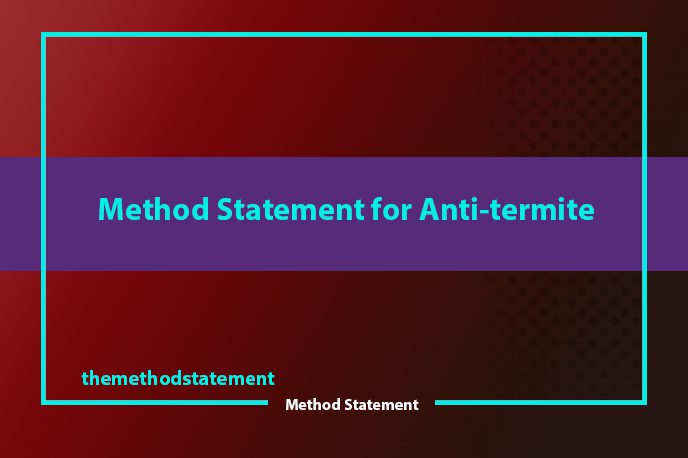What is Method Statement for Anti-termite?
The method statement for anti-termite defines the procedure for the sequence of works for surface treatments and termite control after leveling/compaction of the filled soil and before polythene/damp proof membrane is laid, considering all the necessary safety and quality aspects of the work activities.
Table of Contents
What is the anti-termite treatment?
Anti-termite treatment is a process in which soil treatment is applied to a building in the early stages of its construction. The purpose of anti-termite treatment is to provide the building with a chemical barrier against the sub-terrain termites.
The anti-termite treatment being a specialized job, calls for a thorough knowledge of the chemicals, soils, termites to be dealt with, and the environmental conditions, in order to give effective treatment and lasting protection to the property undergoing treatment.
It is therefore imperative that the works of anti-termite treatment should get executed through specialized agencies only.
The pre-constructional soil treatment is required to be applied during the construction stages (usually under the concrete blindings) of the sub-structure up to the sub-base level.
Presented here is a sample of the method statement that can be formatted as a submittal in the project’s QA documentation.
Purpose
The purpose of this Method Statement for Anti-termite is to define the procedure for the sequence of works for surface treatments and termite control after leveling/compaction of the filled soil and before polythene/damp proof membrane is laid, considering all the necessary safety and quality aspects of the work activities.
Scope of Works
Termite control works for the complete project.
References
3.1. Contract documents
1. Project Specification
2. Contract Drawings
3.2. Contractors Submittal
1. Project Quality Plan
2. Project Safety Plan
3. Material approvals
4. Related method statements
Definitions / Abbreviations
4.1. Definition
1. Project -(Replace with project name)
2. Client -(Replace with clients name)
3. Developer -(Replace with developers name)
4. Consultant -(Replace with consultants name)
5. PMC -(Replace with PMC name)
6. Contractor -(Replace with contractors name)
7. Sub-contractor -(Replace with sub-contractors name)
8. Supplier -(Replace with suppliers name)
4.2. Abbreviations
1. Engineer – Representative of “Name of engineering consultancy”
2. ICL – Inspection Check List
3. IR – Inspection Request
4. ITL -Independent Testing Laboratory
5. ITP – Inspection and Test Plan
6. ITR -Inspection & Test Requests
7. MAT – Material Submittal
8. MEP – Mechanical Electrical Plumbing
9. MET – Method Statement
10. MIR – Material Inspection Request
11. MSDS – Material Safety Data Sheet
12. PPE –Personal Protective Equipment
13. PQP -Project Quality Plan
14. PTW -Permit To Work ( Working at Height or enclosed spaces)
15. RA -Hazard Identification and Risk Assessment
16. RFIA – Request for Inspection and Approval
17. SPD – Shop Drawing
18. TBM – Temporary Bench Mark
See Also: Method Statement for Civil Engineering
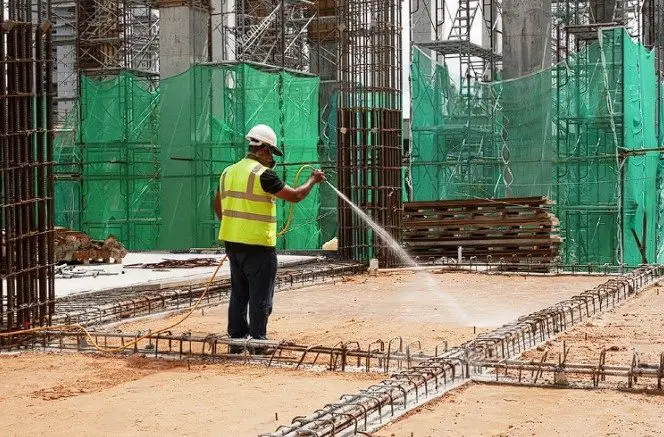
Responsibilities
5.1. Project Manager
1. Ensuring that the project works in his zone are carried out in accordance with Company policies and in accordance with the requirements of this Quality plan.
2. Ensuring the full compliance of subcontractors with Company Quality policies and with the requirements of this Quality plan.
3. To ensure that the subcontractor performs the work as per the contract requirements.
4. To co-ordinate with the Construction Manager, Project Engineer, Safety Engineer, Foreman, and Surveyor for the safe and proper execution of the works.
5. To guide specific attention to all safety measures in coordination with the safety officer/engineer.
5.2. Construction Manager
1. Ensure the area is ready and safe to start the work.
2. Arrange the required visit by the termite treatment subcontractor.
3. Ensure the works are carried out according to the specification, quality, and approved shop drawings.
4. Liaise and coordinate with the Project Manager for the agreed sequence of works with respect to the construction program.
5. Allocation of required manpower through coordination with the Project Manager.
6. Ensure that the risk assessments for the work are understood by all and implemented on-site.
7. Provide sufficient and safe access for operatives, trucks, and pumps.
8. Take precautionary measures with regard to protecting workers from hot weather, wind, rain, and sun.
5.3. Project Engineer
1. The engineer shall carry out his duties in a manner that shall be coordinated by the project manager on a daily basis and shall ensure proper distribution of the workforce and equipment at required locations.
2. Coordinate with the subcontractor on location and the quantity of area to be treated.
3. Coordinate with the Safety Officer to maintain safe working and proper housekeeping of the site. To comply with the safety measures and ensure that all Safety Officer Teams are aware of the same to prevent accidents and losses.
4. To monitor and check all activities and ensure that works shall be carried out according to specifications, quality, and approved drawings.
5. To inform the QC Inspector of the areas ready for inspection.
5.4. QA/QC Engineer / Inspector
1. Ensuring that Consultant/Client inspection requests are implemented.
2. Compilation of all necessary quality control checklists
3. Assisting Consultants during the Inspections.
4. Coordinating with the third-party lab regarding tests and results.
5. The control of work performance by means of checking the work before consultants’ inspection and issuing RFIs & punch lists as necessary.
6. Completion of documentation to verify the work performed.
7. Controlling all inspection activities on-site in line with ITPs.
5.5. Surveyor
1. To establish benchmarks from agreed reference points, provide required setting out and level markings, and follow up with regular checks.
2. Coordinate with the Project Engineer / Foreman and ensure the approved shop drawings/construction drawings shall be implemented properly.
3. Maintain survey details and reports, periodically check the progressing works and advise the project manager of any deviation from the drawings.
5.6. HSE Engineer/Officer
1. Provide the risk assessments for the works in hand.
2. To ensure implementation of all safety measures related to the nature of works being carried out, and in accordance with the Project Safety Plan.
3. To ensure that all the persons involved in the works are aware of their responsibilities and that they have enough understanding of the safety procedures.
4. The safety officer in coordination with the Project Manager shall ensure that all the implemented safety measures are effective enough to maintain safe working on the site.
5. To maintain continuous inspections of the site activities, and advise and train persons on a daily basis to prevent accidents and personnel injury.
6. To give special concern to housekeeping, and ensure that the site is maintained clean and tidy.
7. To ensure all the relevant safety sign boards for different works are in place.
5.7. Foremen/ Works Supervisor
1. Ensure the works are progressed in the sequence as agreed with the Project Manager.
2. Liaise with the Project / Construction Manager for the allocation of the workforce, ensuring adequate manpower is available.
3. Liaise with the site manager to ensure all the required plants/materials are available to construct the works.
4. Full-time supervision shall be required to ensure the works are carried out in accordance with specifications, quality, and approved drawings.
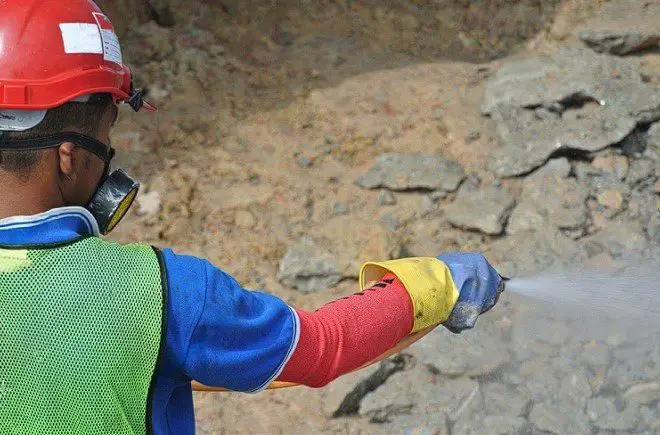
Equipment / Tools / Manpower
6.1. Equipment / Tools
1. 500-liter Tank
2. Pump Machine
6.2. Manpower
1. Project Manager
2. Project Engineer
3. Safety Engineer/Officer
4. Technician
5. Helpers
6.3. Materials
1. Contra Insect from Frunol Delicia (Germany)
2. Water
Note: Quantity of manpower, materials, and types of equipment shall be submitted on the daily progress report.
Procedure
7.1. Anti-Termite Treatment Stages
1. The anti-termite treatment works shall be carried out in four stages during the construction of the building, which are as under:
a. Treatment of Soil under substructure slabs.
b. Treatment of Soil along the External Perimeter of the Building
2. Mixing Chemical
3. For every liter of chemical 49 liters of water shall be mixed. In plain horizontal surfaces, a 5ltr/m2 dose shall be applied. For trenches and edges, a 6ltr/m dose shall be used.
4. Chemical Application
5. one 5-liter dose of chemicals shall be added to the 500-liter tank. The pump machine shall be set to a 20 bar pressure that shall produce a flow of 5 liters per 15 seconds. So, in 15 seconds an area of 1m2 will be covered. For the linear meter applications, the pump shall be set to 15 bar pressure to produce a 6 liter per 20-second flow and this shall cover a distance of one linear meter.
6. Treatment of Soil under Slabs at the Plinth Level
7. The treatment of soil under the concrete slab at the plinth level shall be carried out in the following sequence
7.2. Foundation
1. A trench 200 x 200mm x total perimeter, along with the proposed foundation, shall be excavated.
2. Application of Anti-termite along the trench shall be done with 6 liters per linear meter of (Approved anti-termite material) mixed with water using a 1:49 ratio.
3. Backfill of the trench up to the existing foundation level shall be done in preparation for the second application of Anti-termite.
4. Upon completion, 5 liters per square meter of (Approved anti-termite material) mixed with water (1:49 ratio) shall be applied.
5. On completion, the treated area shall remain undisturbed for two hours. After two hours polyethylene sheets can be placed over the treated area.
6. Preparation for structural works shall be done only within 24 hours for the anti-termite application to remain effective.
7.3. Under Pile Cap
1. On the cleared and leveled ground the anti-termite treatment shall be done using 5 liters per square meter of (Approved anti-termite material) mixed with water using a 1:49 ratio.
2. On completion, the treated area shall be covered with polyethylene sheets after two hours from application.
3. Preparation for structural works shall be done only within 24 hours for the anti-termite application to remain effective.
7.4. Ground Beam/PCC
1. Application of Anti-termite shall be done at the rate of 5 liters per square meter of (Approved anti-termite material) mixed with water at a ratio of 1:49 and covered by polythene sheets after 2 hours.
2. Preparation for structural works shall be done only within 24 hours for the anti-termite application to remain effective.
3. When the ground beam/pick shall be cast, excavate a trench 200 x 200mm along the perimeter of the ground beam/ PCC. The Anti-termite treatment shall be done with 6 liters per linear meter of (Approved anti-termite material) mixed with water using a 1:49 ratio.
4. After completion of the anti-termite application, the trench shall be backfilled.
7.5. Slab on Ground
1. Excavate a trench 200 x 200mm along the perimeter of the slab.
2. Application of anti-termite shall be done with 6 liters per linear meter of (Approved anti-termite material) mixed with water using a 1:49 ratio. After completion, the trench shall be backfilled and leveled.
3. Application of Anti-termite shall be done with 5 liters per square meter of (Approved anti-termite material) mixed with water using a 1:49 ratio along the substructure slab area.
4. On completion, the treated area shall be covered with polyethylene sheets two hours before the application.
5. Treatment to the soil along the external perimeter of the building: Soil around utility pipe openings, floor drains, expansion joints, and electrical conduit entry points shall be sprayed at a rate of 6liters/linear meter with (Approved anti-termite material) mixed in 1:49 ratio with water.
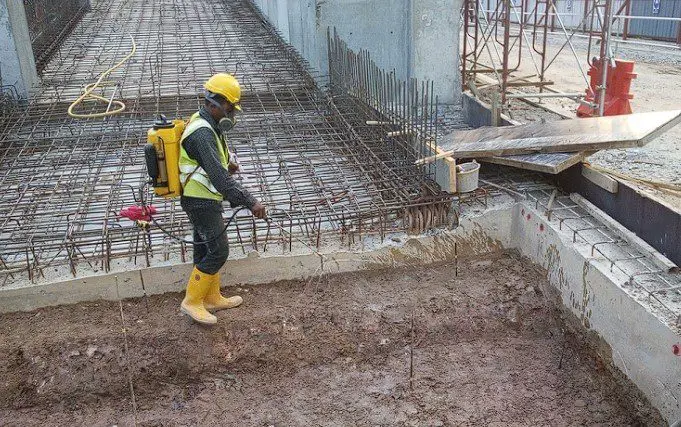
HSE Precautions
1. The applicator must follow the HSE precautions before spraying the pesticide chemical for pest control.
2. The applicator shall wear protective gloves, protective glasses, protective boots or shoes, and protective clothing during mixing, loading, and application.
3. The applicator shall use a respirator with filter A or A/P for the protection of breath.
Attachments
9.1. Inspection Checklists
9.2. Inspection Test Plan
9.3. Risk Assessment
9.4. Technical Datasheet (TDS)
Table Format – Method Statement for Anti-termite
| Section | Information |
| Title | Method Statement for Anti-termite |
| Purpose | Defines the procedure for termite control and surface treatment |
| Scope of Works | Termite control works for the complete project |
| References | Contract documents, project specifications, contract drawings, material approvals, related method statements |
| Definition | Defines various project-related terms and abbreviations |
| Responsibilities | Outlines the responsibilities of the project manager, construction manager, and project engineer |
| Equipment/Tools | Specialized equipment required for anti-termite treatment |
| Procedure | Step-by-step process for anti-termite treatment |
| HSE Precautions | Health, safety, and environmental precautions to be followed during the treatment |
| Attachments | Additional documents required for the project |
tag: # Method Statement for Anti-termite, antitermite method statement
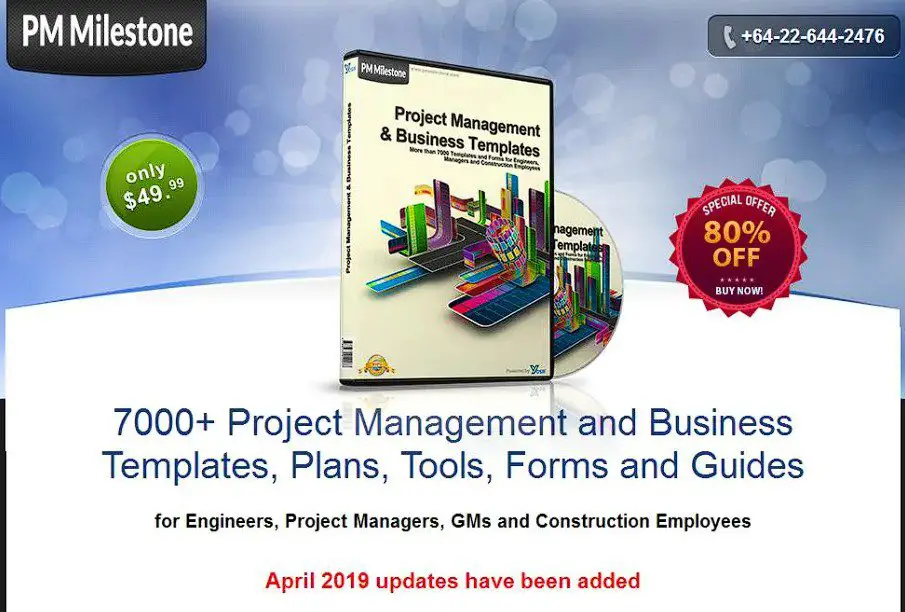
Download these 7000 Premium Templates – Industry Approved used in various Construction Projects which include QA/QC Templates.
We have been using these templates in most of the projects that I am involved with.
Click this link for your download: QA/QC Templates
